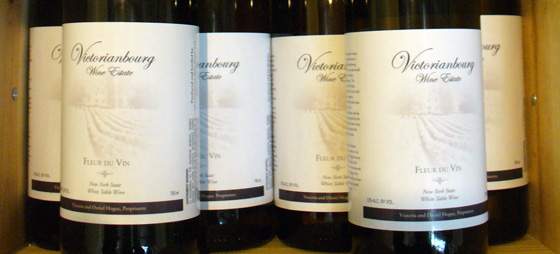By Bryan Calandrelli, Niagara Region Editor
Last week’s opening of Victorianbourg Estate Winery in Wilson, NY is both exciting and important for the Niagara Wine Trail for several reasons. Obviously since our wine region is still so small, with only twelve wineries open, the term “the more the merrier” still rings true. Nearly any addition would be welcomed, but this one is made more exciting by the fact they are primarily using estate fruit for the purpose of making dry wines.
When I met Victorianbourg owner Dan Hogue and I was impressed with what he is growing on his 50-acre property, which sits less than a mile from the shore of Lake Ontario. He’s one of two people growing pinot gris here and from what I’ve tasted, there’s no reason there shouldn’t be more. But what’s most exciting is his commitment to growing pinot noir on the lake shore.
In its initial conception, the Niagara Escarpment AVA was drawn up with pinot noir in mind. Its slopes of clay over limestone, combined with the 200-day growing season, was thought to be perfect for Burgundian pinot. But the AVA itself is an extremely narrow band of land based on elevation that does not include the vineyard-suitable land that stretches north to Lake Ontario.
Until now, there hadn’t been a significant planting of pinot noir on the sandy/gravelly/silty deeper soils closer to the lake. With a longer growing season (from frost to frost) than the escarpment, there’s no doubt that pinot grapes will ripen in Victorianbourg’s vineyards. The question is whether lighter soils can produce concentrated grapes that bring the depth in flavor other wineries are getting with hillside vineyards on the escarpment.
The general fertility and vigor of the soil will play a role in how pinot noir will do. The sloping clay soils of the escarpment keep the plant from getting too vigorous but the soils between the lake and escarpment tend to be more fertile. This can result in more of the vines’ energy going into canopy growth. That means less energy going into ripening the grapes and less concentration of flavor. It’ll be interesting to see how Victorianbourg farms its pinot grapes and how they differ from wineries like Warm lake Estate and Freedom Run Winery.
Along with pinot gris, chardonnay and riesling, Victorianbourg has also added a small planting of gruner veltliner. I’ve been wondering about how gruner would do here, especially closer to the lake, for a long time.
With wineries like Arrowhead Spring with its plantings of syrah and malbec, and now Victorianbourg with gruner, it seems like the newer wineries are more apt to take a risk and experiment with grape varieties. For those of us here able to taste the first wines made from these new vineyards, we’re quickly learning what works where and why. Victorianbourg is adding to the trail’s diversity while providing future wineries with an example of farming grapes like pinot noir and pinot gris where they haven’t been farmed before. That’s why Niagara’s newest winery is so exciting.

